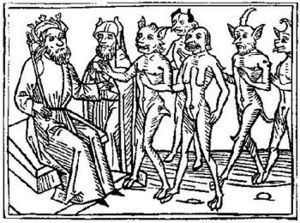Consolatio peccatorum, seu Processus Luciferi contra Jesum Christum
Consolatio peccatorum, seu Processus Luciferi contra Jesum Christum is a tract written by Jacobus de Teramo in around 1382.
[2] In fact "Consolatio peccatorum", describes not one, but two trials between Lucifer and Jesus Christ, before a tribunal presided over by Solomon, in which the devil pursues Christ for having committed an intrusion into his domain during his descent into Hell.
[3] The work must be seen as an allegory to the historical events of the time: the descent of Jesus into hell and the liberation of the Patriarchs is a metaphor of the end of the Avignon papacy and the return of the papacy to Rome (in 1378), the subsequent reaction of the demons is represented by the antipope (Satan).
The solution proposed by Paladini to resolve the dispute between Satan and Jesus, namely to entrust the cause to an impartial tribunal of arbitration, is the one adopted to resolve the schism of the West, with the convening of a council - the first in Pisa (1409), but without success, then at the Council of Constance - which obtained in 1415 the resignation of Pope Gregory XII, overthrew the antipope Benedict XIII of Avignon, and elected Pope Martin V to the papacy.
[4] It was also printed again in 1611 at Hanover, under the title Processus Luciferi contra Iesum coram Iudice Salomone.
